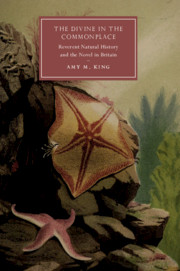Book contents
- The Divine in the Commonplace
- Cambridge Studies in Nineteenth-Century Literature and Culture
- The Divine in the Commonplace
- Copyright page
- Dedication
- Contents
- Figures
- Acknowledgments
- Introduction Natural History, the Theology of Nature, and the Novel
- Chapter 1 Reverent Natural History, the Sketch, and the Novel: Modes of English Realism in White, Mitford, and Austen
- Chapter 2 Early Victorian Natural History: Reverent Empiricism and the Aesthetic of the Commonplace
- Chapter 3 The Formal Realism of Reverent Natural History: Tide-pools, Aquaria, and the Seashore Natural Histories of P. H. Gosse and G. H. Lewes
- Chapter 4 Reverence at the Seashore: Seashore Natural History, Charles Kingsley’s Two Years Ago (1857), and Margaret Gatty’s Parables from Nature (1855)
- Chapter 5 Seeing the Divine in the Commonplace: George Eliot’s Paranaturalist Realism (1856–1859)
- Chapter 6 Elizabeth Gaskell’s Everyday: Reverent Form and Natural Theology in Sylvia’s Lovers (1863) and Wives and Daughters (1866)
- Epilogue Barsetshire via Selborne: Anthony Trollope’s The Last Chronicle of Barset (1867)
- Notes
- Bibliography
- Index
- Cambridge Studies in Nineteenth-Century Literature and Culture
Chapter 5 - Seeing the Divine in the Commonplace: George Eliot’s Paranaturalist Realism (1856–1859)
Published online by Cambridge University Press: 06 July 2019
- The Divine in the Commonplace
- Cambridge Studies in Nineteenth-Century Literature and Culture
- The Divine in the Commonplace
- Copyright page
- Dedication
- Contents
- Figures
- Acknowledgments
- Introduction Natural History, the Theology of Nature, and the Novel
- Chapter 1 Reverent Natural History, the Sketch, and the Novel: Modes of English Realism in White, Mitford, and Austen
- Chapter 2 Early Victorian Natural History: Reverent Empiricism and the Aesthetic of the Commonplace
- Chapter 3 The Formal Realism of Reverent Natural History: Tide-pools, Aquaria, and the Seashore Natural Histories of P. H. Gosse and G. H. Lewes
- Chapter 4 Reverence at the Seashore: Seashore Natural History, Charles Kingsley’s Two Years Ago (1857), and Margaret Gatty’s Parables from Nature (1855)
- Chapter 5 Seeing the Divine in the Commonplace: George Eliot’s Paranaturalist Realism (1856–1859)
- Chapter 6 Elizabeth Gaskell’s Everyday: Reverent Form and Natural Theology in Sylvia’s Lovers (1863) and Wives and Daughters (1866)
- Epilogue Barsetshire via Selborne: Anthony Trollope’s The Last Chronicle of Barset (1867)
- Notes
- Bibliography
- Index
- Cambridge Studies in Nineteenth-Century Literature and Culture
Summary
Chapter 5 focuses on the “paranaturalist realism” of George Eliot’s early career, including her journal sketches “Recollections of Ilfracombe” and “Recollections of Scilly Isle & Jersey” as forerunners of her early fiction: Scenes of Clerical Life (1857) and Adam Bede (1859). Situating Eliot’s emerging turn to realism and fiction amidst two summers of seashore naturalizing with George Henry Lewes, who was writing Sea-Side Studies, the chapter argues that the most resonant connections between Eliot’s fiction and a persistent theology of nature from natural history is her choice to a) write about commonplace everyday human subjects and ordinary particulars, and b) employ descriptive amplitude to appropriate reverence to those subjects. Eliot realizes the aesthetic potential of paranaturalism, borrowing the capacious descriptive practice of reverent natural history in the service of a realist delineation of a human community and natural world. The period 1856-1859 constitutes what I term Eliot’s “naturalist phase”; the chapter deeply explores the biography by way of illuminating the formal elements of Eliot’s emergent realism.
Keywords
- Type
- Chapter
- Information
- The Divine in the CommonplaceReverent Natural History and the Novel in Britain, pp. 168 - 205Publisher: Cambridge University PressPrint publication year: 2019

